4 - 7 July 2004
Article and photos © copyright 2004 by Nicos Neocleous
Sunday 4 July 2004
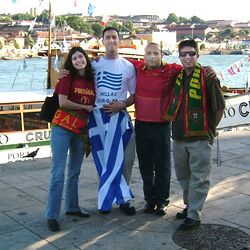 |
| Before the Portugal v Greece European Soccer Final. From left to right: Rebecca Chappa, Nicos Neocleous, Mario Ferreira and David Glancy |
That was a very good question, and the answer was simple enough. In April 2004, I had been invited by my close friend Roy Hersh to be a guest at his annual three day 'Port Wine Cellar Reduction Party'. The event on the third day was a 'diagonal' of varying Port houses from the best vintages over the last six decades. It was here that I had the distinct pleasure of meeting Mario Ferreira, who is responsible in North America for marketing and Port enlightenment of consumers for the Instituto do Vinhos do Douro e do Porto (The Port and Douro Wine Institute). I explained my strong interest in Port wine and we exchanged contact details. A few weeks passed and Mario sent me an e-mail that I almost could not believe. It was an opportunity to visit Oporto and the Douro Valley for four days and I began planning for one of the most entertaining foreign trips of my life.
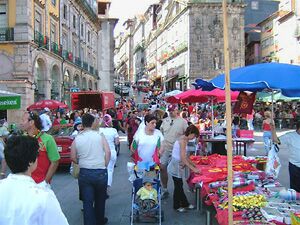 |
| A busy street in Oporto before the soccer final |
I was privileged that Mario Ferreira had travelled all the way from San Francisco to Oporto to be our tour guide and host. I say "we", as there were three wine professionals from San Francisco who would make up the remainder of the party. Once Mario had arrived, we set about the most important task of the moment; where were we going to watch the game? I asked the hotel's concierge if there were any Greek restaurants in Oporto and the answer was no. They did tell us that a huge television screen had been erected in the main square and that would be the place to view the game. The actual game was being played in Lisbon.
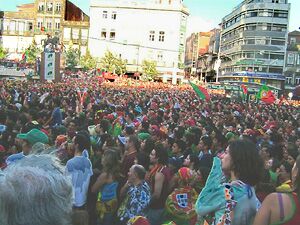 |
| A section of the crowd in Oporto Square minutes before the start of the game |
At the end of ninety minutes, Greece was the victor by one goal to nil after a beautiful header by Angelos Charisteas. The crowd were visibly upset, some were in tears and I genuinely felt sorry for them. On paper, the Portuguese had a stronger and more skilful team, with players such as Figo, Rui Costa and Deco. Random fans then began walking up to me to shake my hand and hug me. They were excellent sports and they appreciated the fact that I had supported my team in the host country. They did say that Greece played better and deserved to win. I was happy to stay until the early hours with my group, drinking beer and joining in the now party-like ambience.
Monday 5 July 2004
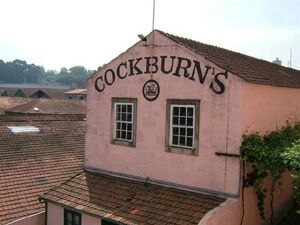 Visit to Cockburn's lodges in Vila Nova de Gaia
Visit to Cockburn's lodges in Vila Nova de Gaia
The short but pleasant drive from the hotel found us at Cockburn's lodge in Oporto. We were introduced to our guide Antonio Graca, who had been with the company for forty-five years! We were treated to some facts and figures about Oporto and the Douro, including:
- Oporto receives as much rainfall on average as Manchester (UK), which is about 1,200mm (nearly 48 inches) per annum.
- Some of the barrels are very old. We were shown a few of the older versions dating from 1935, 1900 and 1898 which were still being used to age Port.
- The standard sized pipes (550 litres) are stacked three high at a time. This weight distribution has helped prevent losses during earthquakes in the past.
Afterwards, we were toured around the extensive warehouse and private cellars. The warehouse was split into areas housing the Cockburn's Ports and the other containing the Martinez (a separate brand) barrels.
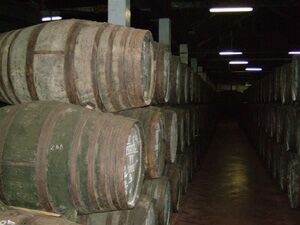 |
| Barrels of Port maturing in the cellars of Cockburn's |
Visit to Graham's lodges in Vila Nova de Gaia
After a skilful navigation of the narrow, winding roads around Oporto, our minibus pulled up to the first of the Graham's lodges in Vila Nova de Gaia. A swift tour ensured that we viewed the cellars and impressive visitor's facility complete with compact gift store. Back in the van and mere moments passed until we arrived at the second lodge. This was one of the offices of the Symington Family and our appointment was with Rupert Symington. He is the joint Managing Director and has responsibility for overall financial planning and sales. A well-organised slide show revealed impressive statistics and also where the main markets were located.
By now it was nearly lunchtime, so Rupert very kindly took us to the tasting room to exercise our taste buds. My impression of the bottles that I sampled can be found in Appendix 2.
Luncheon with Rupert Symington
The tasting did a great job of working up our appetites. A wonderfully traditional three-course lunch was served and gratefully received. The wines that were presented to us at appropriate moments throughout were very enjoyable. See Appendix 2 for details.
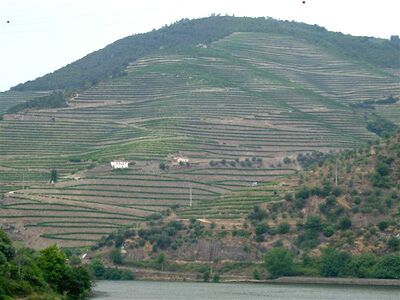 |
| Vineyards near the Vintage House |
Visiting the Douro Valley for the first time
As we climbed back into our sparsely equipped but adequate Transit van, my thoughts now turned to the next instalment of my Portuguese adventure. We were going into the heart of Port country, the Douro Valley where the grapes are actually grown. A wild and remote area, with steep banks rising along the Douro River that run all the way through the heart of the region. Temperatures during the summer often rise to 45C (113F) and working the steep terraces is back breaking. Picking the grapes during the harvest is tortuous labour and not for the weak willed. Our expert driver had been hand picked by the I.V.D.P. and as I peered through the increasingly dust obscured windows to the seemingly vertical drops below, I realised my life was in his hands.
Our destination was the Vintage House for a tasting at 6.30pm. The Vintage House is an old style luxury hotel with a well-stocked wine and Port retail outlet together with an impressive restaurant. This was being hosted by the "Douro Boys", who were an eclectic collection of wine and Port producers. Aside from the possible "Boy band" pop connotations, there were ladies in the group and the men were all at least thirty years old! Still, one cannot but smile at their cheeky use of this name and it certainly stuck in my mind. Each producer was to present their vinous wares to us, pausing for questions and feedback. My tasting notes of the wines and Ports are detailed in Appendix 3.
The "Douro Boys" is made up of the following producers:
- Quinta do Crasto
- Quinta do Vallado
- Quinta do Vale Meao
- Quinta do Vale de D. Maria
- Niepoort
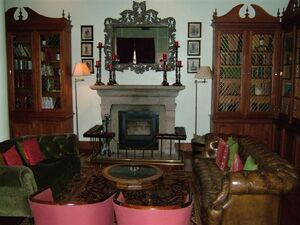 |
| A section of the drawing room of the Vintage House |
Tuesday 6th July
Quinta do Crasto
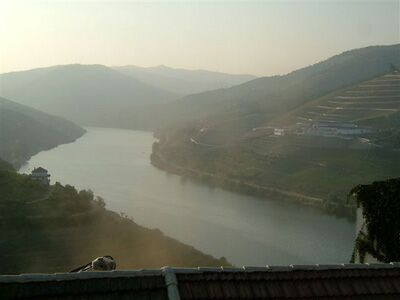 |
| Daybreak on the River Douro from Quinta do Crasto |
Interestingly, I managed to find a limestone marker in my walk. These marked out the boundaries of the Douro area for Port production when it became the first regulated demarcated region in 1756. Their historical significance should not be underestimated and they are now treated as valuable national treasures. Approximately 200 of these markers were erected into the unforgiving ground around 1756, but very few remain. At the time, building materials were scare and limestone blocks were valuable. Some found their way into buildings after being dug up and carted off. The first boundary marker (number 1) was located by accident in the last few years when a railway worker chanced upon it while examining the bank of the Douro River. It is now safely in the I.V.D.P.'s care.
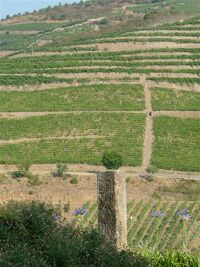 |
| One of the original boundary demarcation markers at Quinta do Crasto |
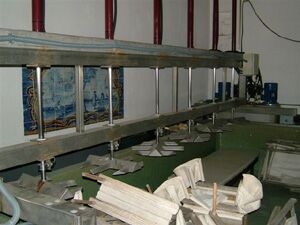 |
| Robotic wine press at Quinta do Crasto |
Visit to Quinta de S.Luiz (Barros)
The vineyards
The first part of our three-person tour was with Jose Manuel Manso, the viticulturist who works for the Quinta. A knowledgeable man, he was clearly passionate about the Douro and its vineyards. We walked a portion of the vineyards and he took time to explain the importance of the terroir. With numerous microclimates contained in the Douro, he informed us the difference between the north and south facing slopes with respect to the ripening of the grapes. The north facing slopes receive sunshine in the morning but not in the afternoon, while the south facing vineyards receive sunshine all day. This can lead to more complexity in the north facing vineyards as they ripen at a slower pace. There was also a distinct policy at Barros to move away from using herbicides over their 100 hectares (250 acres) of vineyards. They own approximately 30 hectares (75 acres) of Touriga Nacional with other grape varieties making up the remainder of the 70 hectares (175 acres). The total estate is 140 hectares (350 acres).
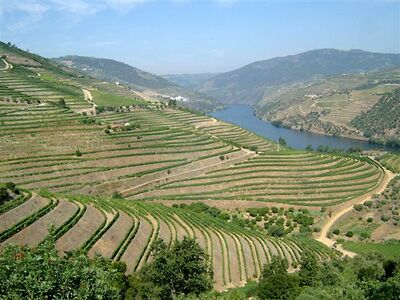 |
| Part of the vineyard terraces at Quinta de S.Luiz (Barros) |
The winery
The second part of our tour consisted of looking at the winemaking process. Pedro Pina Cabral is the current oenologist and he took us around, answering our many questions. The winemaking facilities are extensive, as befits a producer of this size. Well organised and with a mix of sparkling stainless steel for fermentation and large wooden barrels for ageing, the heady smell of Port seemed to caress our senses as we moved from room to room. Of course, they had left the sampling until the end, so we made our way to the tasting room that overlooked the vineyards.
The tasting
Before the tasting began, we were introduced to Manuel Angelo Barros, the family member who is in charge of the overall business. A modest man, he was happy to talk to us to explain his wines and Ports. My impressions of the tasting are listed in Appendix 4.
As we pulled away from Quinta de S.Luiz, the patchwork terraced vineyards stood proudly in the shimmering sun. The air conditioning was working but it did not need to be on full blast. We had been fortunate in that the temperatures in the Douro Valley had dropped significantly over the last couple of days. A comfortable daytime temperature of around 27C (80F) meant that our visits and travelling had not been uncomfortable. Our next destination would be to one of the most famous names in Port production. Aside from making excellent Ports, they own the most famous Port vineyard and one of the most legendary plots of vines on the planet. It was time to visit Quinta do Noval.
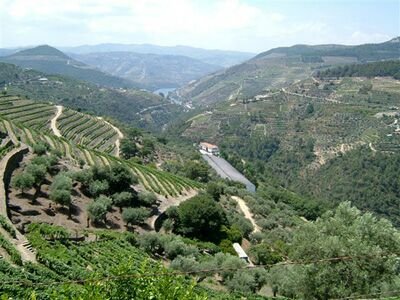 |
| A view of the Douro Valley from Quinta do Noval |
Visit to Quinta do Noval
The immaculate and narrow driveway in the grounds of the Quinta led to a picturesque scene. Various species of trees, shrubbery and plants offering a kaleidoscope of colours, and the warm summer air had a gentle floral scent to it. The views of the vineyards both above and below were stunning, showing the brutal landscape in all of its glory. We took a few moments to admire this scene, then set about learning more about Quinta do Noval.
The first part of our tour was looking at the winemaking facilities and process, with Mrs Ausenda Matos (assistant winemaker) taking us around. It was interesting to see the mix of lagares, stainless steel fermentation tanks and large old wooden barrels for ageing. Another detail that interested me was the robotic equipment that was used in conjunction with the lagares in the pressing of the grapes.
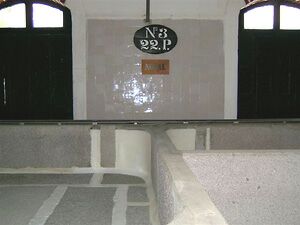 |
| Part of the stone lagares at Quinta do Noval |
I wanted to see and walk the Nacional vineyard, so after a short walk up the steep terraces, we had arrived at this magical spot. When Portugal and the whole of Europe was devastated by Phylloxera in the 19th century, this tiny vineyard of 2.5 hectares (approximately 6.25 acres) remained intact. The Phylloxera louse could not penetrate the roots of the vines in the depths of the schist and gave up. The vineyard was totally replanted in circa 1925 and the six years later the legendary 1931 Nacional was produced. Since then, Port drinkers all over the world have been wowed by the Nacional bottlings and when they are on form, it is the greatest expression of Vintage Port there is. I have had the privilege to drink a number of fine vintages of Nacional and they remain the most awe-inspiring fortified wines I have ever tasted. It is produced in tiny quantities, with approximately 250 cases being made in a declared vintage.
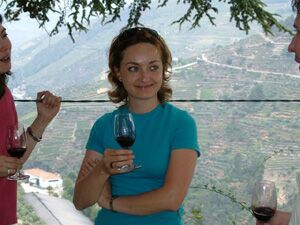 |
| Ms Rute Monteiro of Quinta do Noval |
Lunchtime
And with that, I carried and caressed the bottle of 2000 Nacional all the way to the luncheon venue. We were being honoured by a stunningly prepared series of courses that were served in a beautifully elegant dining room. The mood was relaxed and the extremely tasty courses were matched with lovely wines. I did not take notes on the wines as I wanted to enjoy the meal, but when I tasted the first Port, I reached for my pen and pad. Please refer to Appendix 5 for my tasting notes, including the finest 1970 Vintage Port I have ever tasted.
The lunch had been ever so relaxing and we did not want to leave, but spend a few more hours gently sipping fine port on the terrace. Sadly, we had another appointment, so we bid our farewells. The memories of my time spent at Noval will stay with me for a very long time.
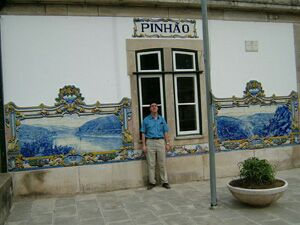 |
| Nicos Neocleous at Pinhao train station in the Douro Valley. Note the tile mosaics on the wall. |
A high-spirited drive along the ever-twisting roads certainly jolted my attention before arriving at our final destination for the day. Located in the Douro Valley was a traditionally Portuguese producer of Port. I had not come across their range before and was therefore looking forward to trying their various bottlings. On arrival, the charming Ms Rita Martins, in charge of public relations, greeted us. The winemaker Joao Nicolau de Almeida managed to join us after a short while and we chatted pleasantly. It was interesting to note that his father was the original winemaker who made the famous Portuguese red wine Barca Velha over forty years ago.
It was mid afternoon and there was some work to be done. A tasting room awaited our presence and we set about the many bottles. My thoughts on the wines are listed in Appendix 6.
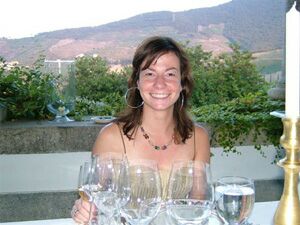 |
| Ms Rita Martins, in charge of public relations at Ramos Pinto |
Wednesday 7th July
Being an early riser, I was busy exploring the grounds and snapping photos before breakfast. There were silhouettes in the vineyards and a peaceful calm before the days work began to avoid the midday heat. Even though the dinner had been generous in proportions and very fine in quality, the wafting aromas of warm dishes switched on my hunger sensors. A very civilised breakfast followed on the terrace, with cheerful conversation. The bright sun shone its rays into our path and relaxed us further. All good things usually come to an end and here was no exception. After breakfast, we said our goodbyes and packed our rested bodies into the van for the final journey of my trip back to Oporto.
Visit to the I.V.D.P. (The Douro and Port Wine Institute)
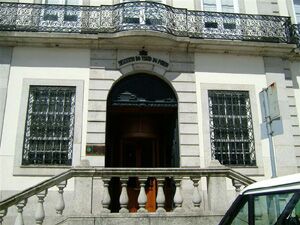 |
| The head office of the I.V.D.P in Oporto |
A swift tour of some of the majestic rooms followed, presenting several photo opportunities. After a short video presentation, our tour moved onto the technical side. Mrs Fry handed the tour baton to Mrs Natalia Moser Ribeiro, who is in charge of the laboratory work. Her job involves many technical facets of the quality control of Port released onto the market. The laboratory handles approximately five thousand different wines every year. They also check samples of the alcohol that is added to make Port the fortified wine that it is. Sources of the alcohol can now come from France, Portugal and Spain.
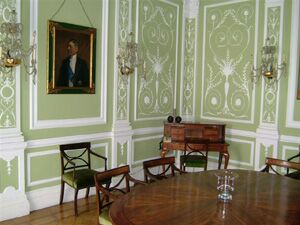 |
| One of the rooms at the I.V.D.P.'s head office in Oporto |
A walk around the laboratories brimming with technical equipment led us to the tasting room. Mr Manuel Maria Pinto, who is one of the trained tasters, took us through the various procedures. Trained laboratory staff are used to evaluate the various samples of Port and wine. There are seven tasters in total (five men, two women). The room is lit with natural daylight, the temperature is 20C (67F) and the room has positive air pressure. Tasting only takes place in the morning and typically consists of twenty bottles at a time. All of the results are recorded on the computers that are organised for each taster. In terms of wine faults that may be detected, these are the options on the computer software: TCA, mould, green stem, soap, rancio, bad wood, atypical smell, onion/garlic/reductive, petrol, unknown, sulphur (SO2), no faults.
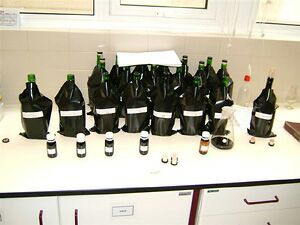 |
| Samples waiting to be tested at the I.V.D.P.'s laboratory |
The tour had ended and it was time for me to leave. My flight back to London left in a little over three hours. I bid my farewells to my fellow wine visitors. Of course, I was very grateful to Mario Ferreira for his touring skills, and to the I.V.D.P. and various Port producers for their hospitality during the whole trip. It had certainly been a packed few days of learning, tasting and socialising with Portuguese wine, Port and its people. I witnessed the constant struggle of man and machine against the harsh natural elements to produce magic in a bottle for wine and Port drinkers all around the world to enjoy at their leisure. The desire of relatively young winemakers to improve and experiment in an ever-competitive world market was admirable and bodes well for the future. This was my first trip to Portugal and I am fairly certain it will not be my last.
(August 2004)




